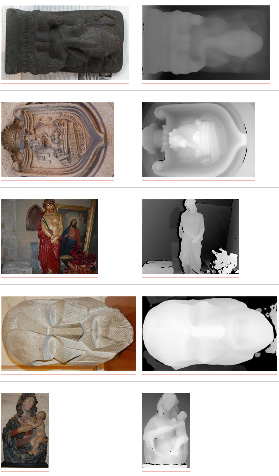Generation of 3D models from photographs
 Dr. David McKinnon (David McKinnon) from the University of Technology in Queensland (Australia) developed a revolutionary 3DSee program that generates 3D models based on ordinary photographs - automatically, without human participation. For the engine to work, you need 5-15 photos that meet the requirements , including should intersect at least 80-90%.
Dr. David McKinnon (David McKinnon) from the University of Technology in Queensland (Australia) developed a revolutionary 3DSee program that generates 3D models based on ordinary photographs - automatically, without human participation. For the engine to work, you need 5-15 photos that meet the requirements , including should intersect at least 80-90%.The system works about the same as Microsoft's Photosynth . He analyzes a pack of photos, finds the point of intersection and automatically sticks together a circular panorama. Here, something similar: a pack of photos is taken, intersection points are searched for, characteristics of the optical system (camera focal length, etc.) are analyzed, a scene geometry file is created and 3D reconstruction is performed. The user is only required to provide content and press one button - that's all!
Automatic 3D modeling is a very difficult and important task, because now a lot of computing and labor resources are being spent on these goals. Given the complexity of the task, it is not surprising that McKinnon took as many as eight years to bring the project to an acceptable level (the 3DSee program is part of the ACID Vision project). Now he wants to improve the technology so that the generation of 3D models in high-resolution pictures will occur automatically (as in the famous scene with “The Matrix” bullets).
On the program's website, you can test the engine on your own photos or browse the gallery of ready-made models. They have low resolution, but this is not a fundamental problem. If the modeling process itself proceeds normally, then the matter is only in computing resources. A full version of the program for powerful servers will appear in the very near future, the author promises .
')
This technology can be used in medicine, military affairs, education, e-commerce, cinema, animation, design, entertainment industry, games for adults, etc. Moreover, now 3D-graphics can become a commonplace and ubiquitous tool and find application in fundamentally new areas where it was not there before. For example, you can easily download a 3D model of your body in Second Life (by the way, this feature will be available soon in 3DSee) or in any other game that uses 3D graphics. You can make 3D scanners to authenticate the person. You can order clothes from the tailor via the Internet. Surely everyone can easily come up with a dozen more applications of this revolutionary technology.
via PhysOrg.com
Source: https://habr.com/ru/post/64080/
All Articles